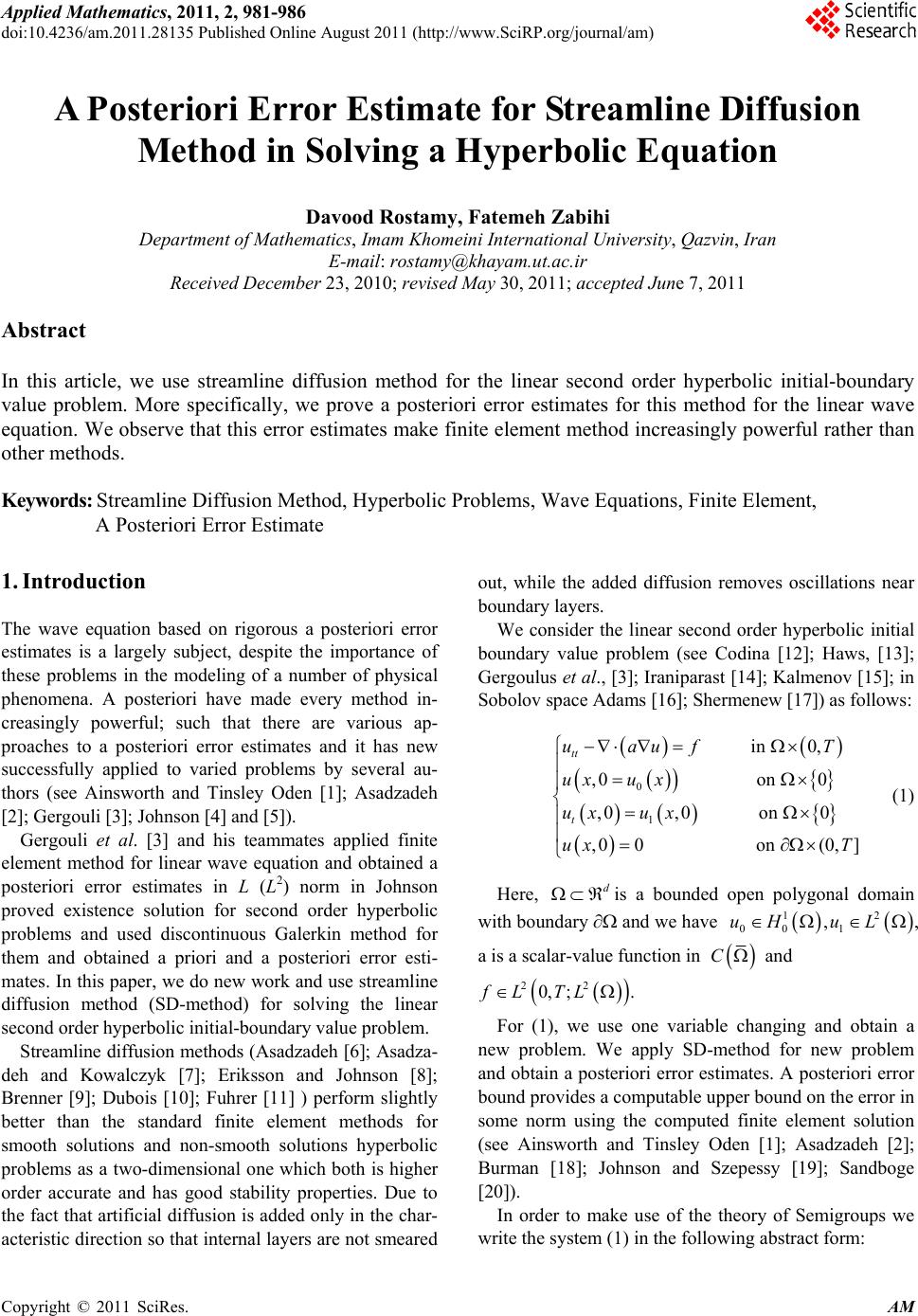 Applied Mathematics, 2011, 2, 981-986 doi:10.4236/am.2011.28135 Published Online August 2011 (http://www.SciRP.org/journal/am) Copyright © 2011 SciRes. AM A Posteriori Error Estimate for Streamline Diffusion Method in Solving a Hyperbolic Equation Davood Rostamy, Fatemeh Zabihi Department of Mat hematics, Imam Khomeini International University, Qazvin, Iran E-mail: rostamy@khayam.ut.ac.ir Received December 23, 2010; revised May 30, 2011; accepted June 7, 2011 Abstract In this article, we use streamline diffusion method for the linear second order hyperbolic initial-boundary value problem. More specifically, we prove a posteriori error estimates for this method for the linear wave equation. We observe that this error estimates make finite element method increasingly powerful rather than other methods. Keywords: Streamline Diffusion Method, Hyperbolic Problems, Wave Equations, Finite Element, A Posteriori Error Estimate 1. Introduction The wave equation based on rigorous a posteriori error estimates is a largely subject, despite the importance of these problems in the modeling of a number of physical phenomena. A posteriori have made every method in- creasingly powerful; such that there are various ap- proaches to a posteriori error estimates and it has new successfully applied to varied problems by several au- thors (see Ainsworth and Tinsley Oden [1]; Asadzadeh [2]; Gergouli [3]; Johnson [4] and [5]). Gergouli et al. [3] and his teammates applied finite element method for linear wave equation and obtained a posteriori error estimates in L (L2) norm in Johnson proved existence solution for second order hyperbolic problems and used discontinuous Galerkin method for them and obtained a priori and a posteriori error esti- mates. In this paper, we do new work and use streamline diffusion method (SD-method) for solving the linear second order hyperbolic initial-boundary value problem. Streamline diffusion methods (Asadzadeh [6]; Asadza- deh and Kowalczyk [7]; Eriksson and Johnson [8]; Brenner [9]; Dubois [10]; Fuhrer [11] ) perform slightly better than the standard finite element methods for smooth solutions and non-smooth solutions hyperbolic problems as a two-dimensional one which both is higher order accurate and has good stability properties. Due to the fact that artificial diffusion is added only in the char- acteristic direction so that internal layers are not smeared out, while the added diffusion removes oscillations near boundary layers. We consider the linear second order hyperbolic initial boundary value problem (see Codina [12]; Haws, [13]; Gergoulus et al., [3]; Iraniparast [14]; Kalmenov [15]; in Sobolov space Adams [16]; Shermenew [17]) as follows: 0 1 in 0, ,0on 0 ,0,0on 0 ,00on(0,] tt t uauf T uxu x ux ux ux T (1) Here, d is a bounded open polygonal domain with boundary and we have 12 00 1 ,uH uL, a is a scalar-value function in C and 22 0, ;fL TL . For (1), we use one variable changing and obtain a new problem. We apply SD-method for new problem and obtain a posteriori error estimates. A posteriori error bound provides a computable upper bound on the error in some norm using the computed finite element solution (see Ainsworth and Tinsley Oden [1]; Asadzadeh [2]; Burman [18]; Johnson and Szepessy [19]; Sandboge [20]). In order to make use of the theory of Semigroups we write the system (1) in the following abstract form: 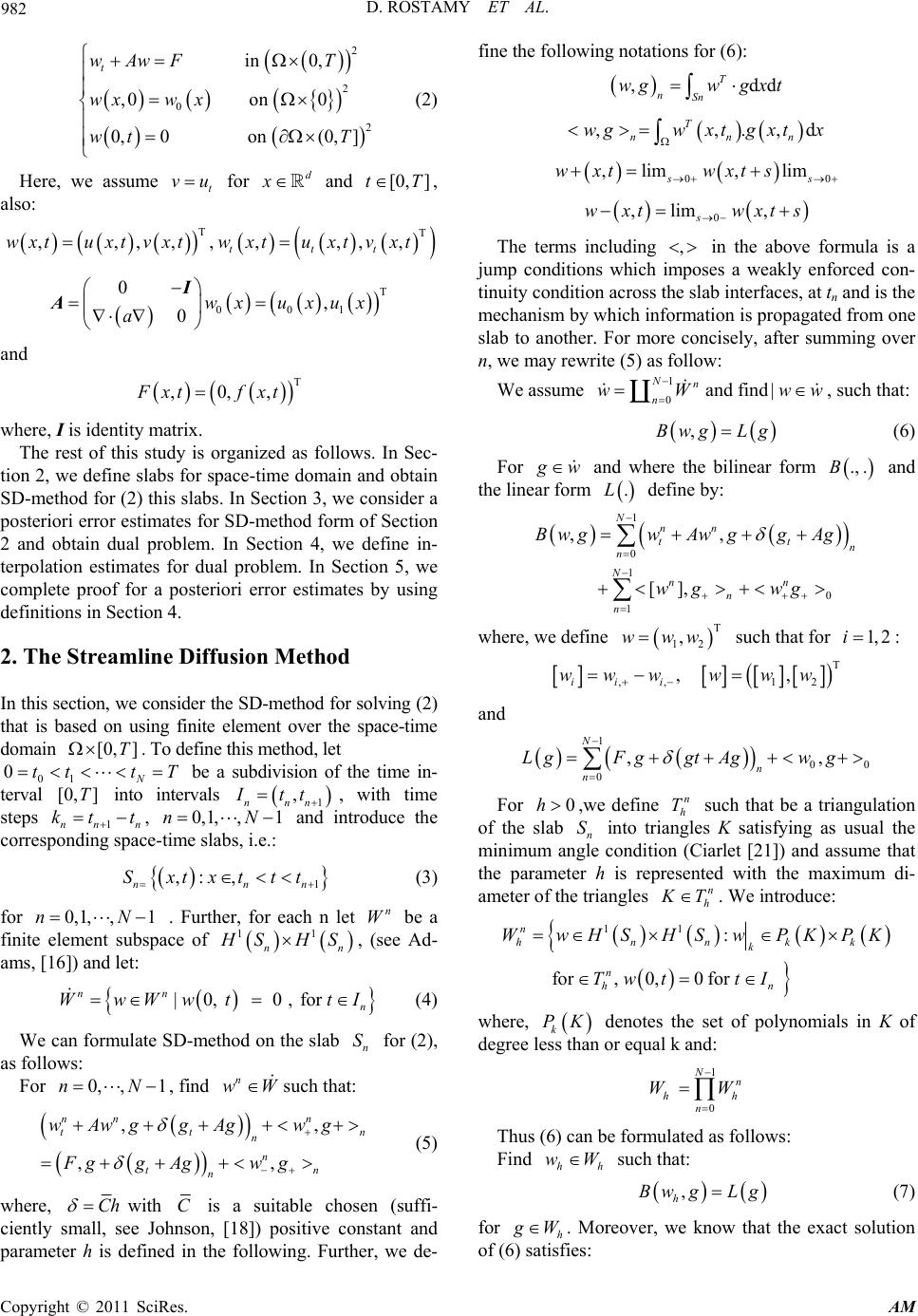 982 D. ROSTAMY ET AL. 2 2 0 2 in 0, ,0on0 0,0on(0, ] t wAwFT wxw x wt T (2) Here, we assume for and t vud x[0, ]tT , also: T ,,,,wxtuxt vxt, T ,,,, ttt wxtuxtvxt T 001 0, 0wx uxux a I A and T ,0,, xtfxt where, I is identity matrix. The rest of this study is organized as follows. In Sec- tion 2, we define slabs for space-time domain and obtain SD-method for (2) this slabs. In Section 3, we consider a posteriori error estimates for SD-method form of Section 2 and obtain dual problem. In Section 4, we define in- terpolation estimates for dual problem. In Section 5, we complete proof for a posteriori error estimates by using definitions in Section 4. 2. The Streamline Diffusion Method In this section, we consider the SD-method for solving (2) that is based on using finite element over the space-time domain . To define this method, let 01 be a subdivision of the time in- terval into intervals [0,]T N tt [0,]T 0t T 1 , nnn tt , 1N , with time steps 1nn n , and introduce the corresponding space-time slabs, i.e.: kt t 0,1,n 1 ,: , nn Sxtxttt n (3) for . Further, for each n let be a finite element subspace of 0,1, ,1nNn W n 11 n SHS, (see Ad- ams, [16]) and let: |0, 0 , for nn n WwWwt tI (4) We can formulate SD-method on the slab for (2), as follows: n S For , find such that: 0, ,1nN n wW , ,, nn n tt n n tn n wAwg gAgwg FggAgw g , n (5) where, Ch with C is a suitable chosen (suffi- ciently small, see Johnson, [18]) positive constant and parameter h is defined in the following. Further, we de- fine the following notations for (6): ,d T nSn wgwgxt d ,d n ,,. T nn wgwxtgxtx 00 , lim,lim ss wxt wxts 0 ,lim , s wxt wxts The terms including , in the above formula is a jump conditions which imposes a weakly enforced con- tinuity condition across the slab interfaces, at tn and is the mechanism by which information is propagated from one slab to another. For more concisely, after summing over n, we may rewrite (5) as follow: We assume and find|, such that: 1 0 Nn n w Www ,Bwg Lg (6) For w and where the bilinear form ., .B and the linear form .L 1N define by: 0 1 0 1 ,, [], nn tt n n Nnn n n Bw gwAwggAg wg wg where, we define such that for T 12 ,www 1, 2i : ,, 12 ,, iii wwww ww T and 1 00 0 ,, N n n LgFggtAgw g For ,we define such that be a triangulation of the slab n into triangles K satisfying as usual the minimum angle condition (Ciarlet [21]) and assume that the parameter h is represented with the maximum di- ameter of the triangles 0hS n h T n h T. We introduce: 11 : for,0,0for n hnnk k n hn WwHSHSwPK PK Tw ttI k where, k PK denotes the set of polynomials in K of degree less than or equal k and: 1 0 Nn hh n WW Thus (6) can be formulated as follows: Find h wW h such that: , h Bw gLg (7) for h W . Moreover, we know that the exact solution of (6) satisfies: Copyright © 2011 SciRes. AM  D. ROSTAMY ET AL. 983 fo ,BwgLg r wand by use (6) and (7), we have the Galerkin ogonorthality relation: ,0Beg (8) where, . An a Posteriori Error Estimate for the this section, we shall consider the following simplified (9) where, h eww . 3SD-Method In version of SD-method for (7) with = 0: Find whWh, such that for 0,1, ,1nN : 1N 1 ,, 01 1 00 0 ,[], , ,, N nn n n ht hhnh n nn N n n wAwgwg wg Fgw g 0 h W and mplicittake 0 ,0 h w. For siy, we 00w and . In order to the error, we ine (10) and denotes the adjoint of the operator L defined in nd 0F con obtain a representation of sider the following auxiliary problem, referred to as the linearized dual problem: Find such that: 1 * 0,0, 0, ,0, T t LA ttT xT x *L (2) a is a positive weight function. Note that this problem is computed “backward”, but there is a corre- sponding change in sign. Further, we shall first introduce the following notation: 2 1/2 () , L www (11) Multiplying (10) by e and integrating by parts and summing over n, we obtain the following error represen- tation formula: 1 2 1 () 1 0 11 00 ,,* , ,, L T Ntn n NN T tnn nn eeeeL eA eeA (12) We have for by part integrating: d (13) We define and 0,1, ,1nN 1 0 1 0 ,dd ,,d d ,,d, n n T tt S n NTT nn t S n NTnnt n n eext extxt xext extxtx e T 12 ,eee T 12 , and ta ob- in for 0,1nN, ,1 : 1 2 2 12 1 1221 21 21 21 21 ,dd 0() dd 10 .() dd (())dd dd () dd , n n n n n n n T S n T S S S S S T n S eAeAxt a ex a ee xt eae xt aeext aeext Aex tAe TT dd t (14) We define: According to (9), 1 0 10 21 12 1 0 11 00 ,, ,, ,, ,, ,, ,, [],,[ ] Tnn n NN NN N NN nn nn Jextxtdx ee ee ee ee ee ee N ., 0 N tT and since 0 e 00w , we get: 1N 0 [], hn n Jw (15) Then in (12), by use (15) and (16), we have: 1 2 11 1 2NN N () 00 0 ,,[], th n n Lnn n eeAew So that recalling (9) and using the Galerkin orthogo- nality (8), we obtain: Copyright © 2011 SciRes. AM 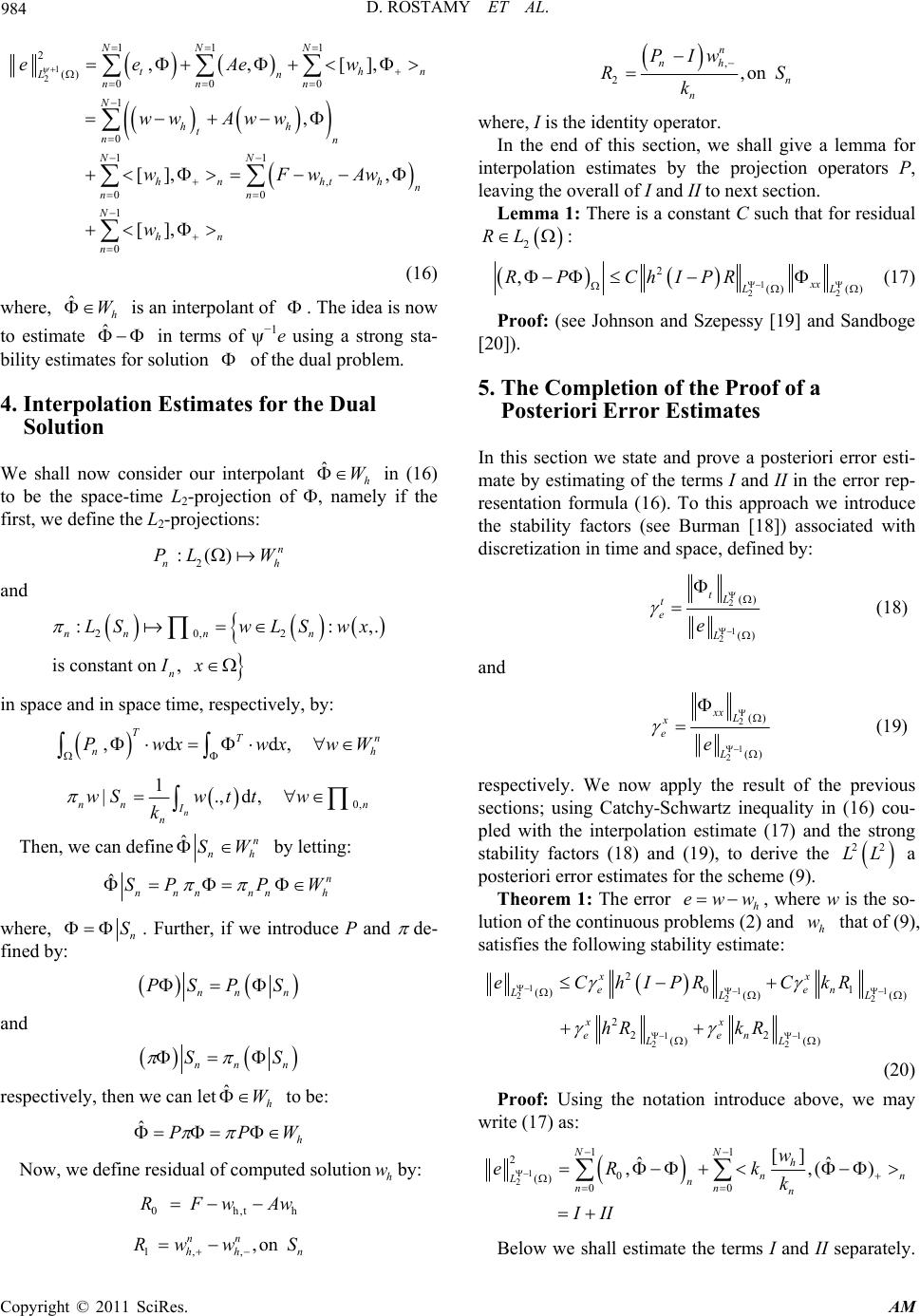 984 D. ROSTAMY ET AL. 1 2, N ee 1 2 1 1 () 00 0 1 0 11 , 00 1 0 ,[], , [], , [], N N thn n Lnn n N hh t nn NN hn hth n nn N hn n Aew ww Aww wFwAw w (16) where, is an interpolant of The idea is ate u tes for the Dual e consider our interpolant in (16) and ˆh W . now to estim in terms of −1esing a strong sta- ˆ es for bility estimatsolution of the dual problem. . Interpolation Es tim a 4Solution shall nowWˆh W , nameto be the space-time L2-projection of ly if the first, we define the L2-projections: 2 :()PL Wn nh 20,2 :: is constant on , nn nn n LSwLS wx Ix ,. in space and in space time, respectively, by: n ,d d, TT nh wxwx w W 0, 1 |.,d, n nn I n wSw t tw k n Then, we can defineˆn nh SW by letting: ˆn nnnh SP W n n P where, n S . Further, if we introduce P and de- : fined by nn n SP S and nn n SS respectively, then we can let to Now, we define residual of computed solutioby: n ˆh W be: ˆh PPW nh w 0h,th RFwAw 1, , ,on nn hh Rw wS , 2,on n nh n n PIw RS k where, I is the identity operator. In the end of this section, we shall give a lemma for projection operators P, le interpolation estimates by the aving the overall of I and II to next section. Lemma 1: There is a constant C such that for residual RL 2 : 1 22 2 () () ,xx LL RP ChIPR (17) Proof: (see Johnson and Szepessy [19] and Sa [20]). Completion of the Proof of a n osteriori error esti- ate by estimating of the terms I and II in the error rep- ndboge 5. The Posteriori Error Estimates this section we state and prove a pI m resentation formula (16). To this approach we introduce the stability factors (see Burman [18]) associated with discretization in time and space, defined by: 2() tL t 1 2() e L e (18) and 2 1 2 () () xx L x e L e (19) respectively. We now apply the result of the previous sections; using Catchy-Schwartz inequality in (16) cou- pled with the interpolation estimate (17) and the strong stability factors (18) and (19), to derive the 22 LL a posteriori error estimates for the scheme (9). Theorem 1: The error h eww , where w so- lution of the continuous problems (2) and wis the that of (9), sa h tisfies the following stabte: ility estima 11 222 2 0 () () x e LL eChIPR C 1 11 22 1 () 2 22 () () x en L xx een LL kR hR kR (20) Proof: Using the notation introduce above, we write (17) as: may 1 11 2 () [] NN L w e 20 00 ˆˆ ,, () h nn n nn n Rk k III Below we shall estimate the terms I and II separately. Copyright © 2011 SciRes. AM 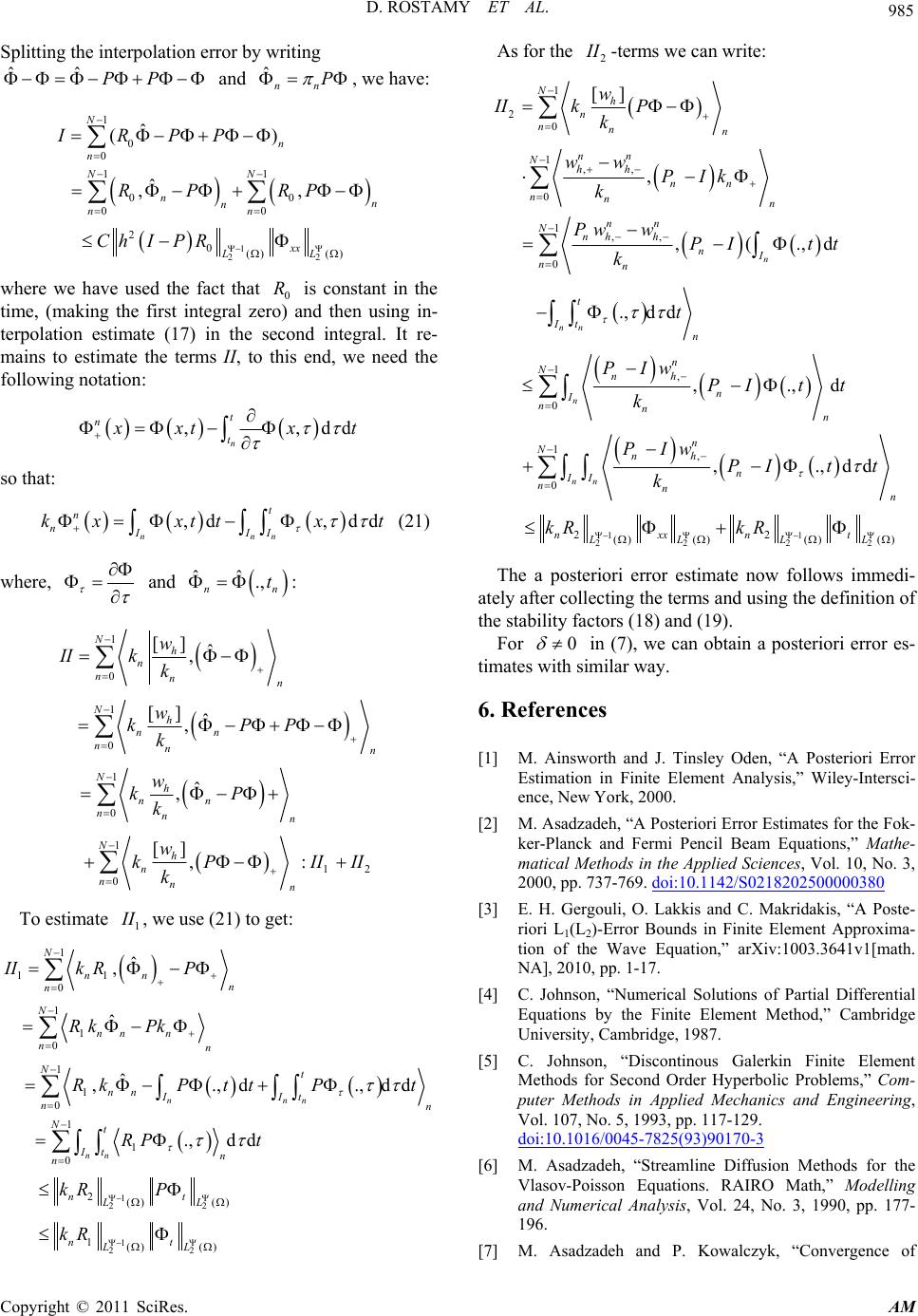 D. ROSTAMY ET AL. 985 Splitting the interpolation error by writing and , we have: ˆˆ PP ˆnn P 1 22 1 0 0 11 () ˆ n n NN IRPP 00 00 2 0() () ˆ ,, N n n xx LL RP RP Ch I PR where we have used the fact that is constant in the time, (making the first integral zero) and then using in- terpolation estimate (17) in the second integral. It re- mains to estimate the terms II, to this end, we need the following notation: n nn 0 R ,,dd n t n t xtx t so that: ,d,dd nnn t n nIII kx xttx t (21) where, and ˆˆ ., nn t : 1 0 1 0 1 0 1 12 0 []ˆ , []wˆ , ˆ , [] ,: Nh n nnn Nh nn nnn Nh nn nnn Nh n nnn w IIk k kPP k w kP k w kPII II k To estimate 1 I, we use (21) to get: 1 22 1 22 1 11 0 1 1 0 nn nn RkPk 1 1 0 1 1 0 2() () 1() () ˆ , ˆ ˆ ,.,d.,dd .,d d nnn nn N nn n n N n Nt nn IIt n Nt It n n nt LL nt LL IIkRP RkPt tPt RP t kR P kR As for the n 2 I-terms we can write: 1 2 1 2 0 1,, 0 1,, 0 1, 0 ,. nn I nn PI k 1, 0 2() [] , ,(.,d .,d d ,d ,.,dd n nn nn Nh n nnn nn Nhh nn nnn nn Nnhh nI nn t It n n Nnh n n Nnh n II nnn nL w IIk P k wwPIk k Pw wPI tt k t PIw t t PIw PIt t k kR 1 222 2 ()() () xx nt LLL kR The a posteriori error estimate now follows immedi- ately after collecting the terms and using the definition of the stability factors (18) and (19). For 0 in (7), we can obtain a posteriori error es- timates with similar way. 6. References [1] M. Ainsworth and J. Tinsley Oden, “A Posteriori Error Estimation in Finite Element Analysis,” Wiley-Intersci- ence, New York, 2000. [2] M. Asadzadeh, “A Posteriori Error Estimates for the Fok- ker-Planck and Fermi Pencil Beam Equations,” Mathe- matical Methods in the Applied Sciences, Vol. 10, No. 3, 2000, pp. 737-769. doi:10.1142/S0218202500000380 [3] [4] Element Method,” Cambridge “Discontinous Galerkin Finite Element Hyperbolic Problems,” Com- E. H. Gergouli, O. Lakkis and C. Makridakis, “A Poste- riori L1(L2)-Error Bounds in Finite Element Approxima- tion of the Wave Equation,” arXiv:1003.3641v1[math. NA], 2010, pp. 1-17. C. Johnson, “Numerical Solutions of Partial Differential Equations by the Finite University, Cambridge, 1987. [5] C. Johnson, Methods for Second Order puter Methods in Applied Mechanics and Engineering, Vol. 107, No. 5, 1993, pp. 117-129. doi:10.1016/0045-7825(93)90170-3 [6] M. Asadzadeh, “Streamline Diffusion Methods for the Vlasov-Poisson Equations. RAIRO Math,” Modelling and Numerical Analysis, Vol. 24, No. 3, 1990, pp. 177- 196. [7] M. Asadzadeh and P. Kowalczyk, “Convergence of Copyright © 2011 SciRes. AM 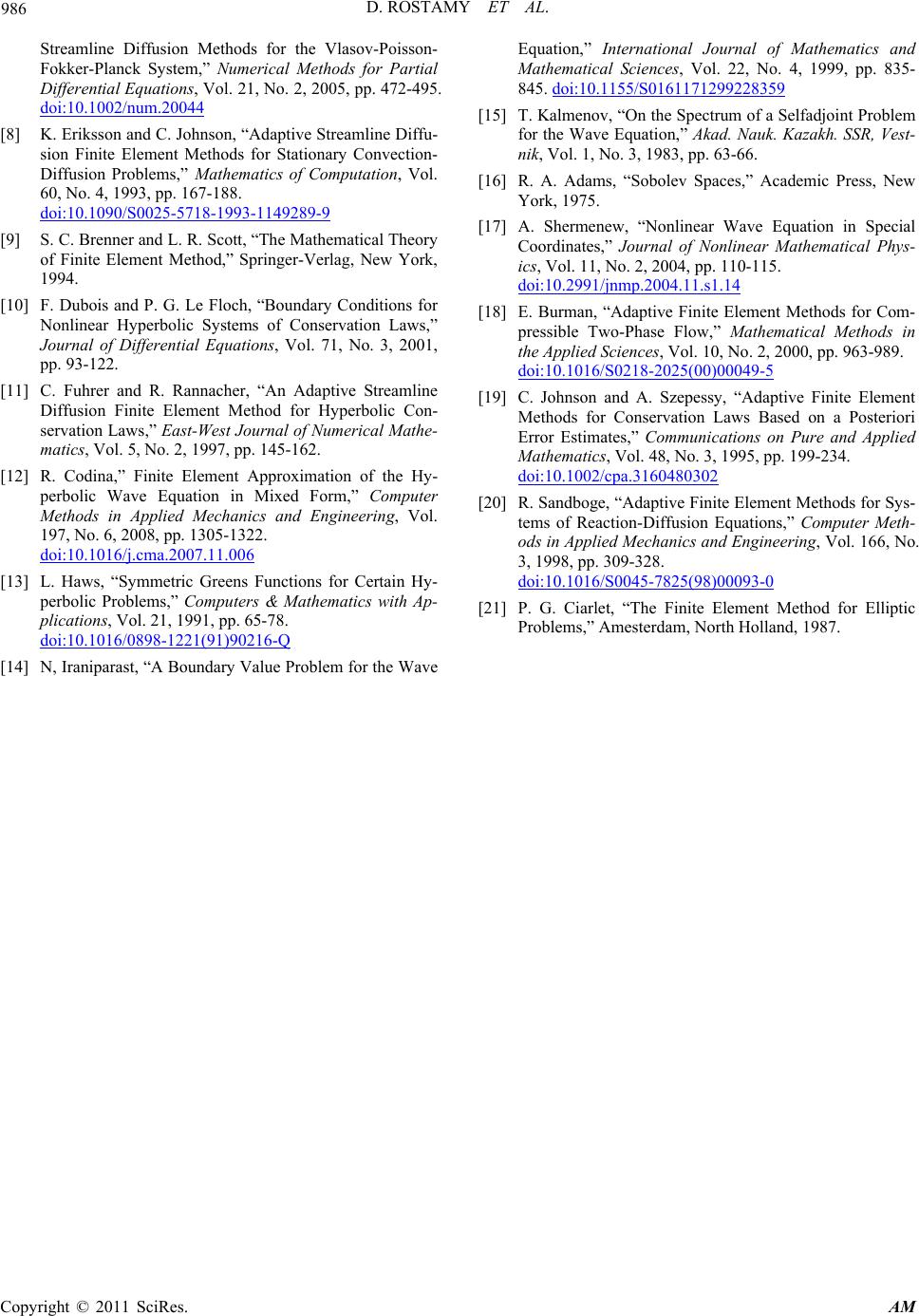 D. ROSTAMY ET AL. Copyright © 2011 SciRes. AM 986 4 Streamline Diffusion Methods for the Vlasov-Poisson- Fokker-Planck System,” Numerical Methods for Partial Differential Equations, Vol. 21, No. 2, 2005, pp. 472-495. doi:10.1002/num.2004 tics of Computation, Vol. [8] K. Eriksson and C. Johnson, “Adaptive Streamline Diffu- sion Finite Element Methods for Stationary Convection- Diffusion Problems,” Mathema 60, No. 4, 1993, pp. 167-188. doi:10.1090/S0025-5718-1993-1149289-9 [9] S. C. Brenner and L. R. Scott, “The Mathematical Theory of Finite Element Method,” Springer- 1994. Verlag, New York, -122. ent Approximation of the Hy- [10] F. Dubois and P. G. Le Floch, “Boundary Conditions for Nonlinear Hyperbolic Systems of Conservation Laws,” Journal of Differential Equations, Vol. 71, No. 3, 2001, pp. 93 [11] C. Fuhrer and R. Rannacher, “An Adaptive Streamline Diffusion Finite Element Method for Hyperbolic Con- servation Laws,” East-West Journal of Numerical Mathe- matics, Vol. 5, No. 2, 1997, pp. 145-162. [12] R. Codina,” Finite Elem perbolic Wave Equation in Mixed Form,” Computer Methods in Applied Mechanics and Engineering, Vol. 197, No. 6, 2008, pp. 1305-1322. doi:10.1016/j.cma.2007.11.006 [13] L. Haws, “Symmetric Greens Functions for Certain H 1016/0898-1221(91)90216-Q y- perbolic Problems,” Computers & Mathematics with Ap- plications, Vol. 21, 1991, pp. 65-78. doi:10. 59 [14] N, Iraniparast, “A Boundary Value Problem for the Wave Equation,” International Journal of Mathematics and Mathematical Sciences, Vol. 22, No. 4, 1999, pp. 835- 845. doi:10.1155/S01611712992283 of a Selfadjoint Problem demic Press, New [15] T. Kalmenov, “On the Spectrum for the Wave Equation,” Akad. Nauk. Kazakh. SSR, Vest- nik, Vol. 1, No. 3, 1983, pp. 63-66. [16] R. A. Adams, “Sobolev Spaces,” Aca York, 1975. [17] A. Shermenew, “Nonlinear Wave Equation in Special Coordinates,” Journal of Nonlinear Mathematical Phys- ics, Vol. 11, No. 2, 2004, pp. 110-115. doi:10.2991/jnmp.2004.11.s1.14 [18] E. Burman, “Adaptive Finite Element Methods for Com- pressible Two-Phase Flow,” Mathematical Methods in the Applied Sciences, Vol. 10, No. 2, 2000, pp. 963-989. doi:10.1016/S0218-2025(00)00049-5 [19] C. Johnson and A. Szepessy, “Adaptive Finite Element 99-234. Methods for Conservation Laws Based on a Posteriori Error Estimates,” Communications on Pure and Applied Mathematics, Vol. 48, No. 3, 1995, pp. 1 doi:10.1002/cpa.3160480302 [20] R. Sandboge, “Adaptive Finite Element Methods for Sys- tems of Reaction-Diffusion Equations,” Computer Meth- ods in Applied Mechanics and Engineering, Vol. 166, No. 3, 1998, pp. 309-328. doi:10.1016/S0045-7825(98)00093-0 [21] P. G. Ciarlet, “The Finite Element Method for Elliptic Problems,” Amesterdam, North Holland, 1987.
|